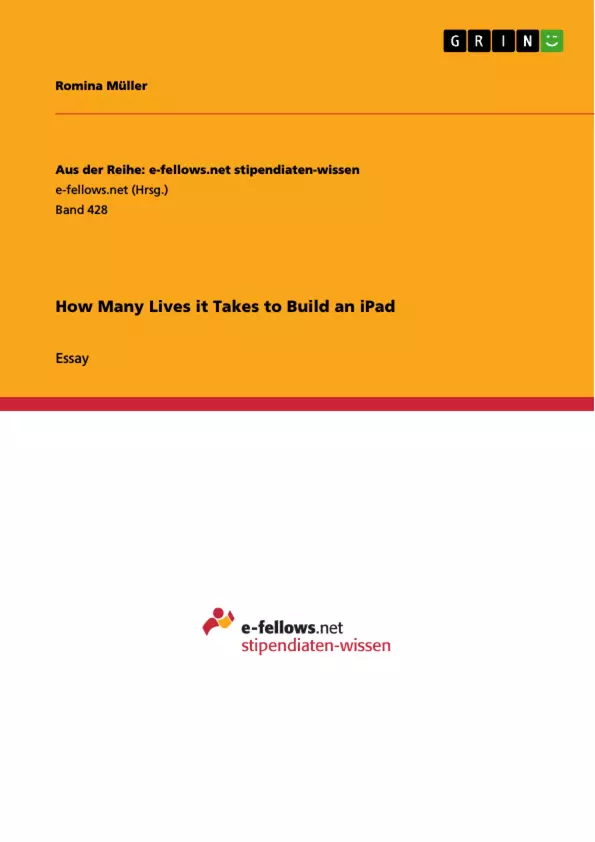Today, Apple is one of the most prestigious brands worldwide and the forerunner in technical inventions. The death of CEO Steve Jobs in October 2011 only boosted the popularity of the brand, which managed to successfully sell millions of its iPhones, iPods, and iMacs over the last years. However, with the release of its newest product, the iPad, in April 2010, Apple did not only accomplish to invent another highly demanded product, but also revealed the negative site of its business even more: the horrific working conditions in its Chinese factories.
Inhaltsverzeichnis (Table of Contents)
- How Many Lives it Takes to Build an iPad
- Apple's Response to the Disclosure of Bad Working Conditions
- Apple's Current Tactic
- Crisis Management
- Reinsuring Customers' Trust in the Brand and its Products
- Following Up on the Improved Working Conditions
- Conclusion
Zielsetzung und Themenschwerpunkte (Objectives and Key Themes)
This text examines the negative consequences of Apple's business practices in China, particularly focusing on the horrific working conditions in its factories. It analyzes Apple's response to the disclosure of these conditions and explores potential strategies for crisis management and restoring public trust.- The detrimental effects of Apple's pursuit of low production costs on worker safety and well-being.
- Apple's inadequate response to the disclosure of labor abuses in its Chinese factories.
- The importance of effective crisis management in mitigating reputational damage.
- Strategies for regaining customer trust in Apple and its products.
- The ethical implications of global supply chains and the responsibility of multinational corporations.
Zusammenfassung der Kapitel (Chapter Summaries)
- How Many Lives it Takes to Build an iPad: This chapter introduces the issue of Apple's reliance on Chinese factories with poor working conditions and the negative consequences associated with their pursuit of low production costs. It highlights the contrast between Apple's reputation as a prestigious brand and the reality of its manufacturing practices.
- Apple's Response to the Disclosure of Bad Working Conditions: This chapter examines Apple's response to the public disclosure of the deplorable working conditions in its Chinese factories. It criticizes Apple's statements about improving factory conditions as insufficient and lacking credibility, highlighting the lack of concrete actions taken by the company.
- Apple's Current Tactic: This chapter analyzes Apple's current strategy of relying on its suppliers to address labor violations without taking proactive measures. It suggests that Apple's reliance on vague codes of conduct and superficial statements about improved working conditions fails to adequately address the underlying issues.
- Crisis Management: This chapter proposes a comprehensive crisis management strategy for Apple, focusing on quick and decisive action to mitigate reputational damage stemming from incidents like explosions in its Chinese factories. It outlines specific measures, including honest communication, investment in safety measures, and support for affected workers.
- Reinsuring Customers' Trust in the Brand and its Products: This chapter focuses on strategies for regaining customer trust in Apple and its products. It suggests that Apple needs to address the negative image associated with its production practices by providing customers with more opportunities to experience its products and by demonstrating its commitment to improving working conditions.
- Following Up on the Improved Working Conditions: This chapter emphasizes the importance of ongoing monitoring and transparency in ensuring improved working conditions in Apple's Chinese factories. It suggests regular check-ups, media access, and a system for employees to report concerns directly to Apple headquarters.
Schlüsselwörter (Keywords)
This text explores the complex relationship between Apple, its Chinese suppliers, and the ethical implications of global manufacturing. Key concepts include working conditions, labor abuses, crisis management, brand reputation, consumer trust, and corporate social responsibility. The analysis focuses on the interconnectedness of these themes, highlighting the need for companies like Apple to take proactive steps to address the ethical challenges associated with their supply chains.
Final del extracto de 3 páginas
- subir
- Citar trabajo
- Romina Müller (Autor), 2012, How Many Lives it Takes to Build an iPad, Múnich, GRIN Verlag, https://www.grin.com/document/194064
Leer eBook



